Personal and Professional Development Strategies: ASDA Report
VerifiedAdded on 2020/07/22
|15
|4262
|105
Report
AI Summary
This report analyzes personal and professional development within ASDA, focusing on self-managed learning and its benefits for both employees and the organization. It explores different learning styles, identifies workplace issues and their solutions, and examines time management strategies. The report includes a skills and competencies audit, identifies developmental needs, and proposes a personal and professional development plan. It emphasizes the importance of self-assessment, goal setting, and continuous improvement, providing insights into how ASDA can promote employee growth and career planning. The report covers various aspects like approaches to self-managed learning, lifelong learning methods, benefits to individual and organization, major workplace issues and their solutions, learning styles, and time management strategies. Furthermore, it includes an audit of personal skills, identification of developmental needs, and the creation of a development plan, along with the processes and activities required for its implementation.
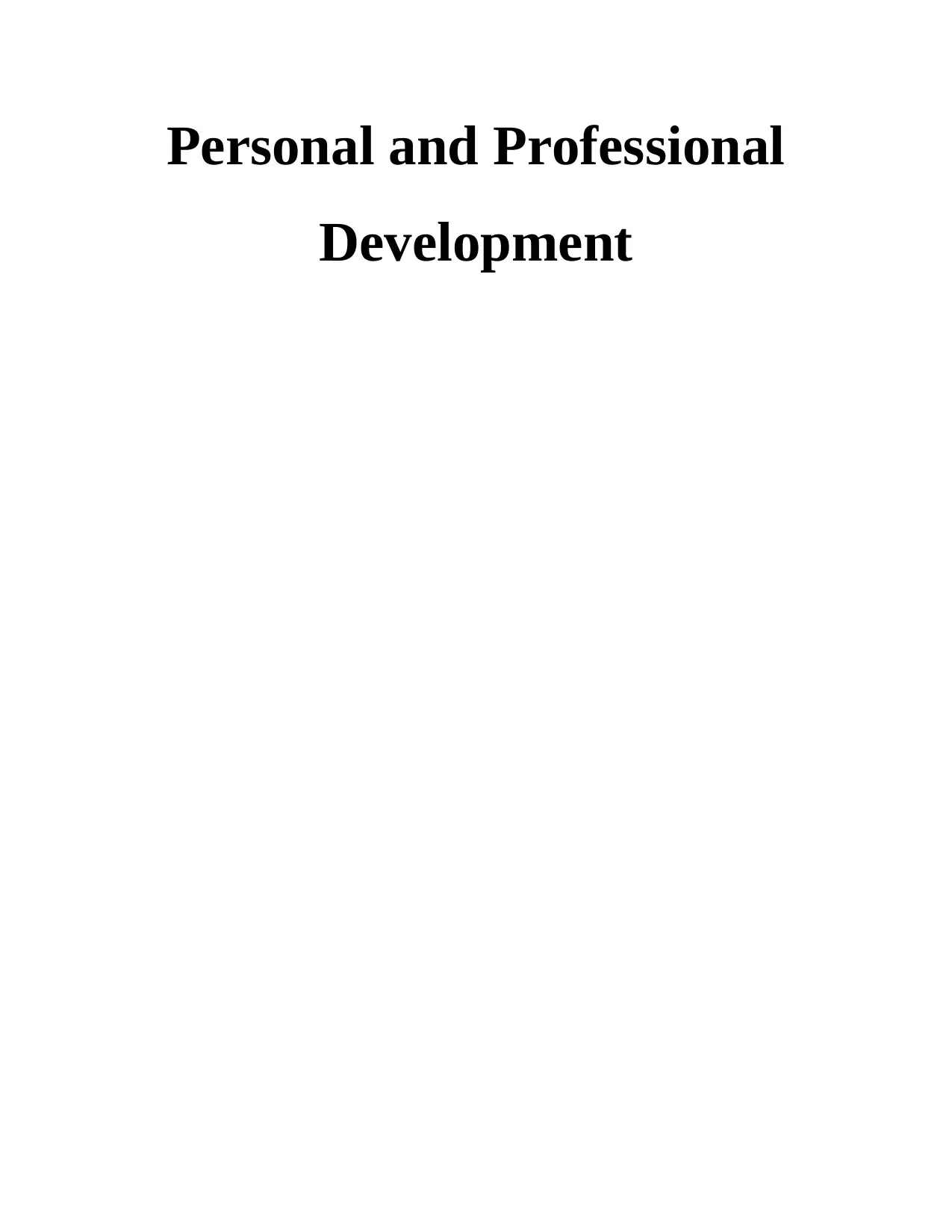
Personal and Professional
Development
Development
Paraphrase This Document
Need a fresh take? Get an instant paraphrase of this document with our AI Paraphraser
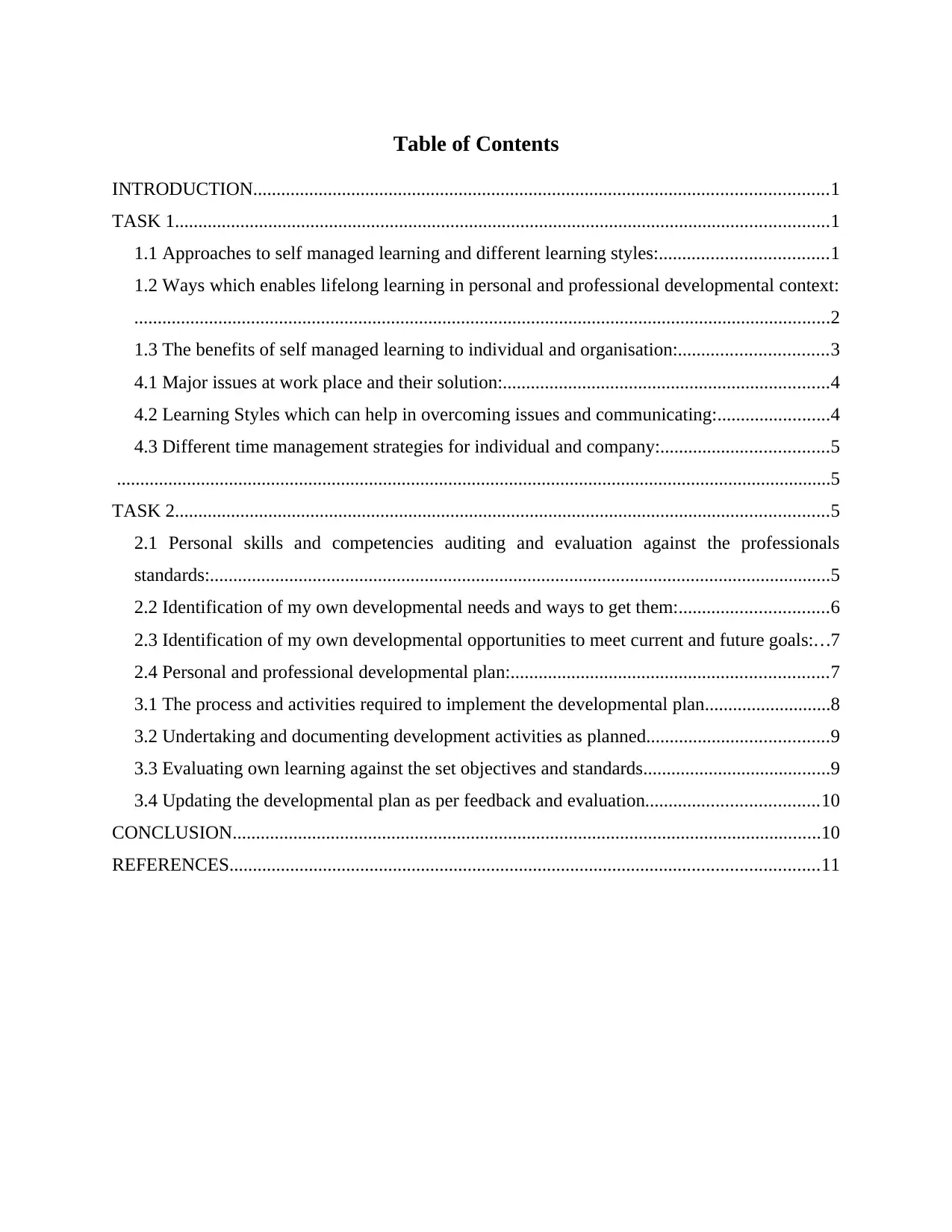
Table of Contents
INTRODUCTION...........................................................................................................................1
TASK 1............................................................................................................................................1
1.1 Approaches to self managed learning and different learning styles:....................................1
1.2 Ways which enables lifelong learning in personal and professional developmental context:
.....................................................................................................................................................2
1.3 The benefits of self managed learning to individual and organisation:................................3
4.1 Major issues at work place and their solution:......................................................................4
4.2 Learning Styles which can help in overcoming issues and communicating:........................4
4.3 Different time management strategies for individual and company:....................................5
.........................................................................................................................................................5
TASK 2............................................................................................................................................5
2.1 Personal skills and competencies auditing and evaluation against the professionals
standards:.....................................................................................................................................5
2.2 Identification of my own developmental needs and ways to get them:................................6
2.3 Identification of my own developmental opportunities to meet current and future goals:...7
2.4 Personal and professional developmental plan:....................................................................7
3.1 The process and activities required to implement the developmental plan...........................8
3.2 Undertaking and documenting development activities as planned.......................................9
3.3 Evaluating own learning against the set objectives and standards........................................9
3.4 Updating the developmental plan as per feedback and evaluation.....................................10
CONCLUSION..............................................................................................................................10
REFERENCES..............................................................................................................................11
INTRODUCTION...........................................................................................................................1
TASK 1............................................................................................................................................1
1.1 Approaches to self managed learning and different learning styles:....................................1
1.2 Ways which enables lifelong learning in personal and professional developmental context:
.....................................................................................................................................................2
1.3 The benefits of self managed learning to individual and organisation:................................3
4.1 Major issues at work place and their solution:......................................................................4
4.2 Learning Styles which can help in overcoming issues and communicating:........................4
4.3 Different time management strategies for individual and company:....................................5
.........................................................................................................................................................5
TASK 2............................................................................................................................................5
2.1 Personal skills and competencies auditing and evaluation against the professionals
standards:.....................................................................................................................................5
2.2 Identification of my own developmental needs and ways to get them:................................6
2.3 Identification of my own developmental opportunities to meet current and future goals:...7
2.4 Personal and professional developmental plan:....................................................................7
3.1 The process and activities required to implement the developmental plan...........................8
3.2 Undertaking and documenting development activities as planned.......................................9
3.3 Evaluating own learning against the set objectives and standards........................................9
3.4 Updating the developmental plan as per feedback and evaluation.....................................10
CONCLUSION..............................................................................................................................10
REFERENCES..............................................................................................................................11

⊘ This is a preview!⊘
Do you want full access?
Subscribe today to unlock all pages.

Trusted by 1+ million students worldwide
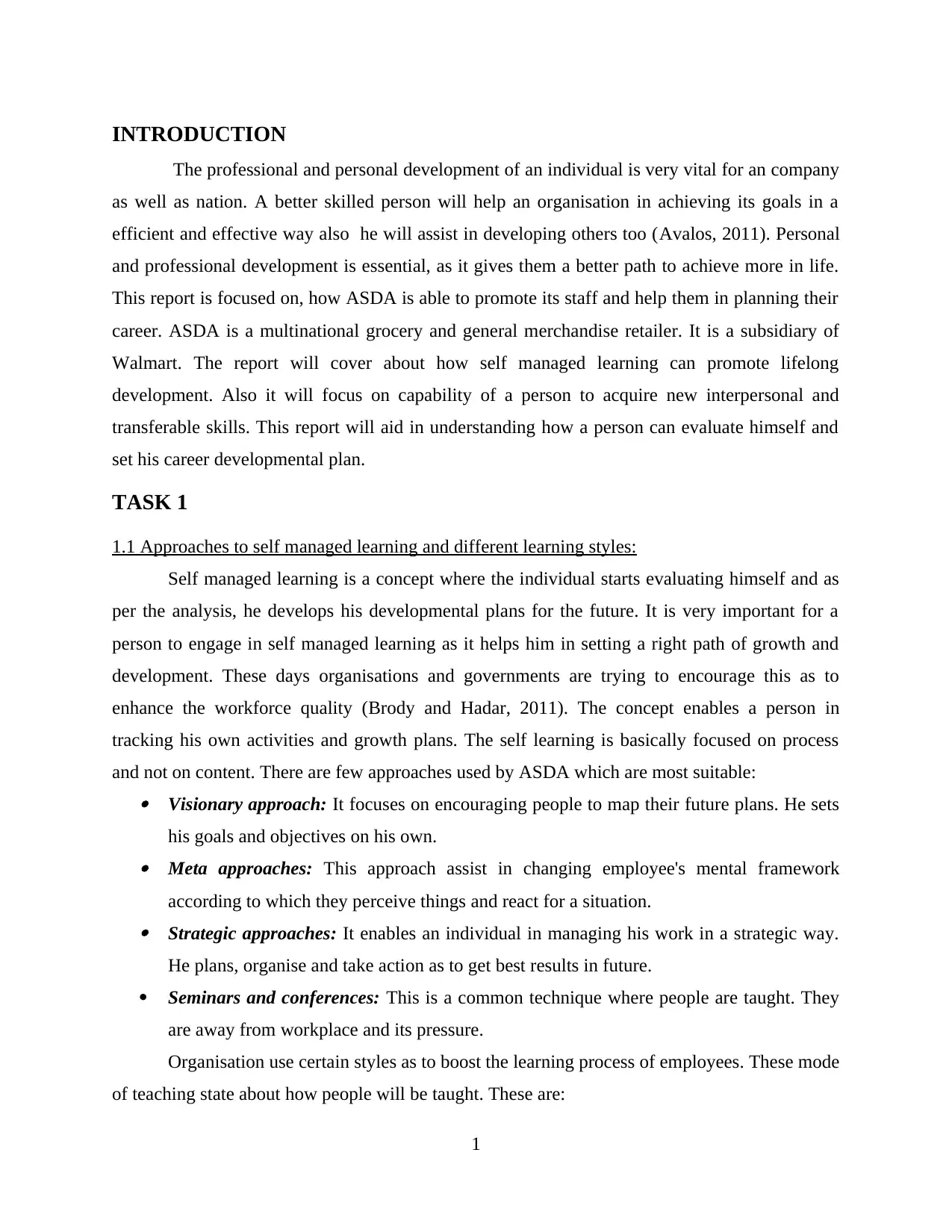
INTRODUCTION
The professional and personal development of an individual is very vital for an company
as well as nation. A better skilled person will help an organisation in achieving its goals in a
efficient and effective way also he will assist in developing others too (Avalos, 2011). Personal
and professional development is essential, as it gives them a better path to achieve more in life.
This report is focused on, how ASDA is able to promote its staff and help them in planning their
career. ASDA is a multinational grocery and general merchandise retailer. It is a subsidiary of
Walmart. The report will cover about how self managed learning can promote lifelong
development. Also it will focus on capability of a person to acquire new interpersonal and
transferable skills. This report will aid in understanding how a person can evaluate himself and
set his career developmental plan.
TASK 1
1.1 Approaches to self managed learning and different learning styles:
Self managed learning is a concept where the individual starts evaluating himself and as
per the analysis, he develops his developmental plans for the future. It is very important for a
person to engage in self managed learning as it helps him in setting a right path of growth and
development. These days organisations and governments are trying to encourage this as to
enhance the workforce quality (Brody and Hadar, 2011). The concept enables a person in
tracking his own activities and growth plans. The self learning is basically focused on process
and not on content. There are few approaches used by ASDA which are most suitable: Visionary approach: It focuses on encouraging people to map their future plans. He sets
his goals and objectives on his own. Meta approaches: This approach assist in changing employee's mental framework
according to which they perceive things and react for a situation. Strategic approaches: It enables an individual in managing his work in a strategic way.
He plans, organise and take action as to get best results in future.
Seminars and conferences: This is a common technique where people are taught. They
are away from workplace and its pressure.
Organisation use certain styles as to boost the learning process of employees. These mode
of teaching state about how people will be taught. These are:
1
The professional and personal development of an individual is very vital for an company
as well as nation. A better skilled person will help an organisation in achieving its goals in a
efficient and effective way also he will assist in developing others too (Avalos, 2011). Personal
and professional development is essential, as it gives them a better path to achieve more in life.
This report is focused on, how ASDA is able to promote its staff and help them in planning their
career. ASDA is a multinational grocery and general merchandise retailer. It is a subsidiary of
Walmart. The report will cover about how self managed learning can promote lifelong
development. Also it will focus on capability of a person to acquire new interpersonal and
transferable skills. This report will aid in understanding how a person can evaluate himself and
set his career developmental plan.
TASK 1
1.1 Approaches to self managed learning and different learning styles:
Self managed learning is a concept where the individual starts evaluating himself and as
per the analysis, he develops his developmental plans for the future. It is very important for a
person to engage in self managed learning as it helps him in setting a right path of growth and
development. These days organisations and governments are trying to encourage this as to
enhance the workforce quality (Brody and Hadar, 2011). The concept enables a person in
tracking his own activities and growth plans. The self learning is basically focused on process
and not on content. There are few approaches used by ASDA which are most suitable: Visionary approach: It focuses on encouraging people to map their future plans. He sets
his goals and objectives on his own. Meta approaches: This approach assist in changing employee's mental framework
according to which they perceive things and react for a situation. Strategic approaches: It enables an individual in managing his work in a strategic way.
He plans, organise and take action as to get best results in future.
Seminars and conferences: This is a common technique where people are taught. They
are away from workplace and its pressure.
Organisation use certain styles as to boost the learning process of employees. These mode
of teaching state about how people will be taught. These are:
1
Paraphrase This Document
Need a fresh take? Get an instant paraphrase of this document with our AI Paraphraser
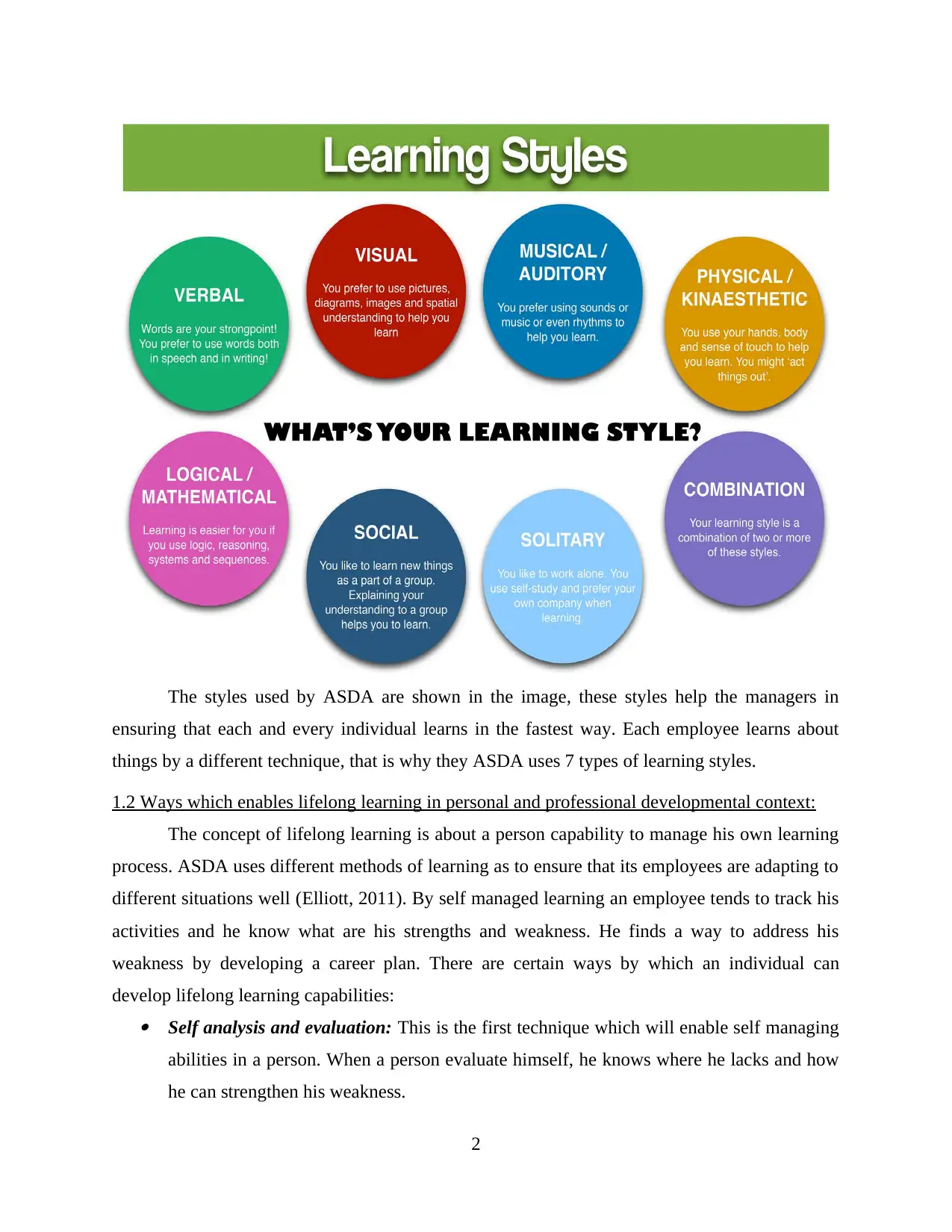
The styles used by ASDA are shown in the image, these styles help the managers in
ensuring that each and every individual learns in the fastest way. Each employee learns about
things by a different technique, that is why they ASDA uses 7 types of learning styles.
1.2 Ways which enables lifelong learning in personal and professional developmental context:
The concept of lifelong learning is about a person capability to manage his own learning
process. ASDA uses different methods of learning as to ensure that its employees are adapting to
different situations well (Elliott, 2011). By self managed learning an employee tends to track his
activities and he know what are his strengths and weakness. He finds a way to address his
weakness by developing a career plan. There are certain ways by which an individual can
develop lifelong learning capabilities: Self analysis and evaluation: This is the first technique which will enable self managing
abilities in a person. When a person evaluate himself, he knows where he lacks and how
he can strengthen his weakness.
2
ensuring that each and every individual learns in the fastest way. Each employee learns about
things by a different technique, that is why they ASDA uses 7 types of learning styles.
1.2 Ways which enables lifelong learning in personal and professional developmental context:
The concept of lifelong learning is about a person capability to manage his own learning
process. ASDA uses different methods of learning as to ensure that its employees are adapting to
different situations well (Elliott, 2011). By self managed learning an employee tends to track his
activities and he know what are his strengths and weakness. He finds a way to address his
weakness by developing a career plan. There are certain ways by which an individual can
develop lifelong learning capabilities: Self analysis and evaluation: This is the first technique which will enable self managing
abilities in a person. When a person evaluate himself, he knows where he lacks and how
he can strengthen his weakness.
2
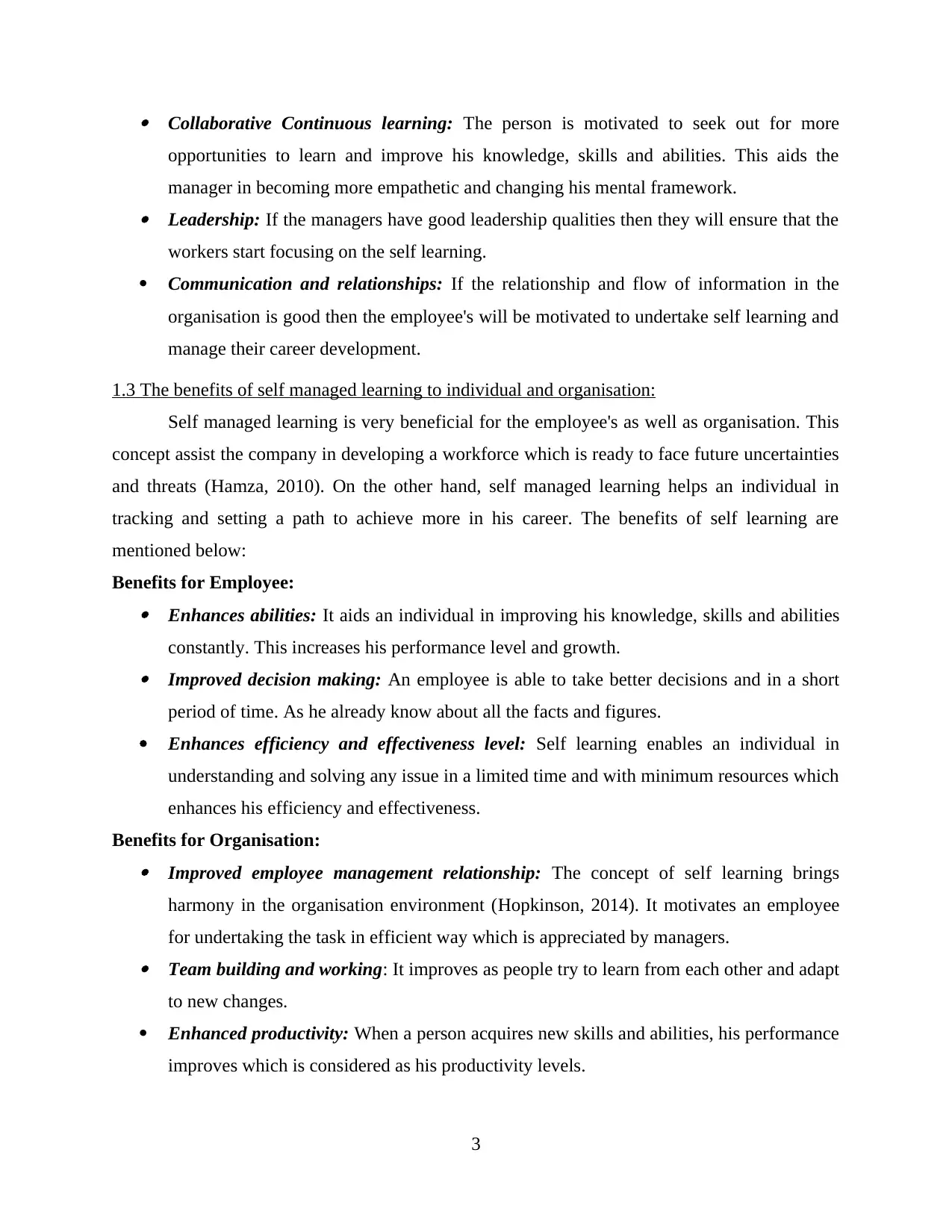
Collaborative Continuous learning: The person is motivated to seek out for more
opportunities to learn and improve his knowledge, skills and abilities. This aids the
manager in becoming more empathetic and changing his mental framework. Leadership: If the managers have good leadership qualities then they will ensure that the
workers start focusing on the self learning.
Communication and relationships: If the relationship and flow of information in the
organisation is good then the employee's will be motivated to undertake self learning and
manage their career development.
1.3 The benefits of self managed learning to individual and organisation:
Self managed learning is very beneficial for the employee's as well as organisation. This
concept assist the company in developing a workforce which is ready to face future uncertainties
and threats (Hamza, 2010). On the other hand, self managed learning helps an individual in
tracking and setting a path to achieve more in his career. The benefits of self learning are
mentioned below:
Benefits for Employee: Enhances abilities: It aids an individual in improving his knowledge, skills and abilities
constantly. This increases his performance level and growth. Improved decision making: An employee is able to take better decisions and in a short
period of time. As he already know about all the facts and figures.
Enhances efficiency and effectiveness level: Self learning enables an individual in
understanding and solving any issue in a limited time and with minimum resources which
enhances his efficiency and effectiveness.
Benefits for Organisation: Improved employee management relationship: The concept of self learning brings
harmony in the organisation environment (Hopkinson, 2014). It motivates an employee
for undertaking the task in efficient way which is appreciated by managers. Team building and working: It improves as people try to learn from each other and adapt
to new changes.
Enhanced productivity: When a person acquires new skills and abilities, his performance
improves which is considered as his productivity levels.
3
opportunities to learn and improve his knowledge, skills and abilities. This aids the
manager in becoming more empathetic and changing his mental framework. Leadership: If the managers have good leadership qualities then they will ensure that the
workers start focusing on the self learning.
Communication and relationships: If the relationship and flow of information in the
organisation is good then the employee's will be motivated to undertake self learning and
manage their career development.
1.3 The benefits of self managed learning to individual and organisation:
Self managed learning is very beneficial for the employee's as well as organisation. This
concept assist the company in developing a workforce which is ready to face future uncertainties
and threats (Hamza, 2010). On the other hand, self managed learning helps an individual in
tracking and setting a path to achieve more in his career. The benefits of self learning are
mentioned below:
Benefits for Employee: Enhances abilities: It aids an individual in improving his knowledge, skills and abilities
constantly. This increases his performance level and growth. Improved decision making: An employee is able to take better decisions and in a short
period of time. As he already know about all the facts and figures.
Enhances efficiency and effectiveness level: Self learning enables an individual in
understanding and solving any issue in a limited time and with minimum resources which
enhances his efficiency and effectiveness.
Benefits for Organisation: Improved employee management relationship: The concept of self learning brings
harmony in the organisation environment (Hopkinson, 2014). It motivates an employee
for undertaking the task in efficient way which is appreciated by managers. Team building and working: It improves as people try to learn from each other and adapt
to new changes.
Enhanced productivity: When a person acquires new skills and abilities, his performance
improves which is considered as his productivity levels.
3
⊘ This is a preview!⊘
Do you want full access?
Subscribe today to unlock all pages.

Trusted by 1+ million students worldwide
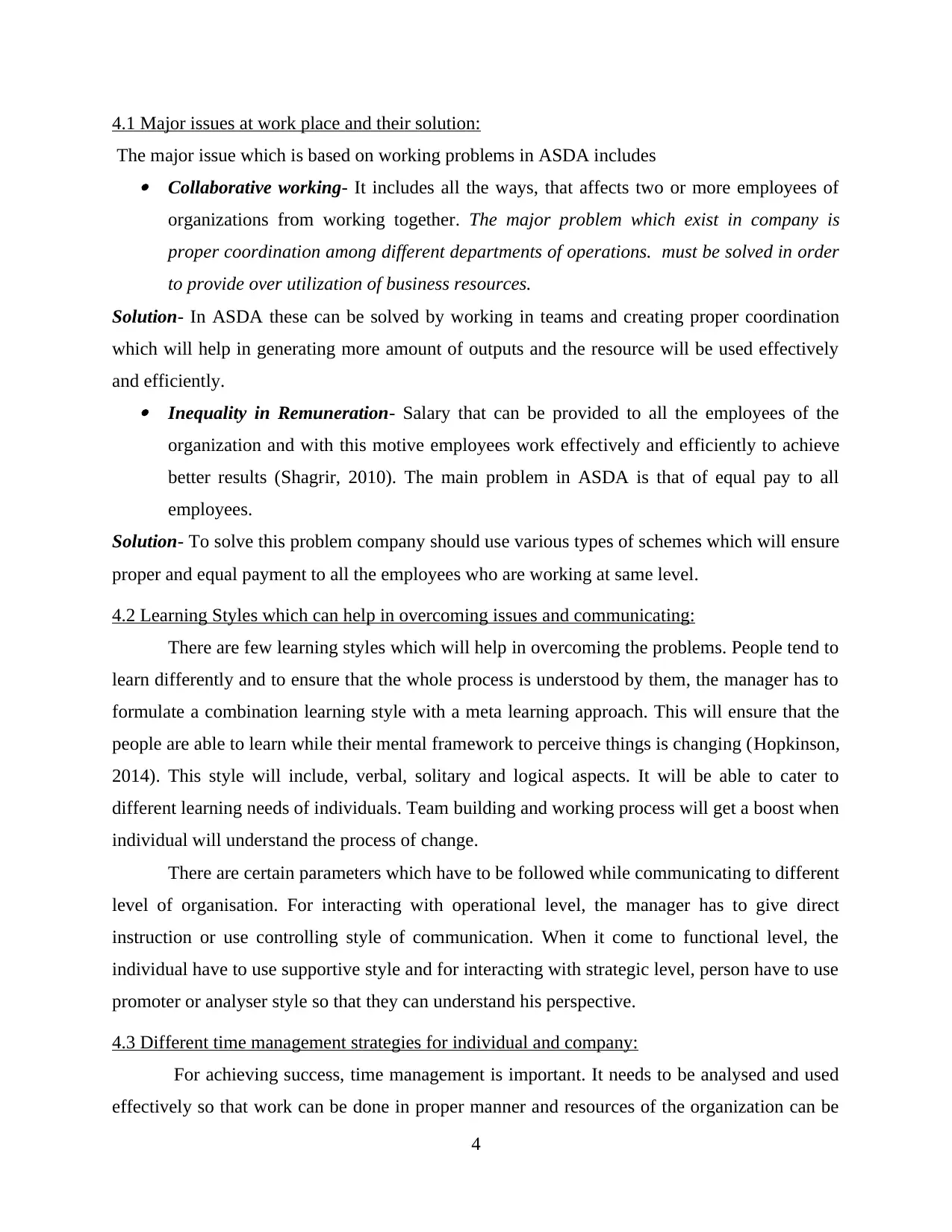
4.1 Major issues at work place and their solution:
The major issue which is based on working problems in ASDA includes Collaborative working- It includes all the ways, that affects two or more employees of
organizations from working together. The major problem which exist in company is
proper coordination among different departments of operations. must be solved in order
to provide over utilization of business resources.
Solution- In ASDA these can be solved by working in teams and creating proper coordination
which will help in generating more amount of outputs and the resource will be used effectively
and efficiently. Inequality in Remuneration- Salary that can be provided to all the employees of the
organization and with this motive employees work effectively and efficiently to achieve
better results (Shagrir, 2010). The main problem in ASDA is that of equal pay to all
employees.
Solution- To solve this problem company should use various types of schemes which will ensure
proper and equal payment to all the employees who are working at same level.
4.2 Learning Styles which can help in overcoming issues and communicating:
There are few learning styles which will help in overcoming the problems. People tend to
learn differently and to ensure that the whole process is understood by them, the manager has to
formulate a combination learning style with a meta learning approach. This will ensure that the
people are able to learn while their mental framework to perceive things is changing (Hopkinson,
2014). This style will include, verbal, solitary and logical aspects. It will be able to cater to
different learning needs of individuals. Team building and working process will get a boost when
individual will understand the process of change.
There are certain parameters which have to be followed while communicating to different
level of organisation. For interacting with operational level, the manager has to give direct
instruction or use controlling style of communication. When it come to functional level, the
individual have to use supportive style and for interacting with strategic level, person have to use
promoter or analyser style so that they can understand his perspective.
4.3 Different time management strategies for individual and company:
For achieving success, time management is important. It needs to be analysed and used
effectively so that work can be done in proper manner and resources of the organization can be
4
The major issue which is based on working problems in ASDA includes Collaborative working- It includes all the ways, that affects two or more employees of
organizations from working together. The major problem which exist in company is
proper coordination among different departments of operations. must be solved in order
to provide over utilization of business resources.
Solution- In ASDA these can be solved by working in teams and creating proper coordination
which will help in generating more amount of outputs and the resource will be used effectively
and efficiently. Inequality in Remuneration- Salary that can be provided to all the employees of the
organization and with this motive employees work effectively and efficiently to achieve
better results (Shagrir, 2010). The main problem in ASDA is that of equal pay to all
employees.
Solution- To solve this problem company should use various types of schemes which will ensure
proper and equal payment to all the employees who are working at same level.
4.2 Learning Styles which can help in overcoming issues and communicating:
There are few learning styles which will help in overcoming the problems. People tend to
learn differently and to ensure that the whole process is understood by them, the manager has to
formulate a combination learning style with a meta learning approach. This will ensure that the
people are able to learn while their mental framework to perceive things is changing (Hopkinson,
2014). This style will include, verbal, solitary and logical aspects. It will be able to cater to
different learning needs of individuals. Team building and working process will get a boost when
individual will understand the process of change.
There are certain parameters which have to be followed while communicating to different
level of organisation. For interacting with operational level, the manager has to give direct
instruction or use controlling style of communication. When it come to functional level, the
individual have to use supportive style and for interacting with strategic level, person have to use
promoter or analyser style so that they can understand his perspective.
4.3 Different time management strategies for individual and company:
For achieving success, time management is important. It needs to be analysed and used
effectively so that work can be done in proper manner and resources of the organization can be
4
Paraphrase This Document
Need a fresh take? Get an instant paraphrase of this document with our AI Paraphraser

effectively and efficiently used to achieve organizational success (Shortland, 2010). Various time
management strategies which are appropriate for company and individual are:
The various-strategies used by ASDA are Setting objectives- The objectives must be formulated in order to provide effective and
efficient resources of business organizations. Organise Resources- It will help in reducing the time to find resources in between the
working time period. Scheduling- Schedule such activities which ensures proper and effective time used in
generating working benefits of the company. Timely Finish- This refers to timely completion of all the task as states in the plan. Adjusting working hours- By proper adjustments in working hours work can be
completed on time and resources can be used effectively.
Preparing list- It will help in prioritising the task as per their value.
TASK 2
2.1 Personal skills and competencies auditing and evaluation against the professionals standards:
When individuals do self appraisals they come to know about their strengths and
weakness. Also it enables them in identifying opportunities and threats which exist in the market
environment (Kumari, 2011). The auditing helps a person in setting goals and objectives as per
the SMART criteria. In my own case, there are few skills which makes me more competent than
others such as my problem solving skills, management of people, team building, target
achievement, providing motivation, researching and listening. As a store manager in Asda my
audit will be :
Sl. Skills and Competencies Score Score from Variances
5
management strategies which are appropriate for company and individual are:
The various-strategies used by ASDA are Setting objectives- The objectives must be formulated in order to provide effective and
efficient resources of business organizations. Organise Resources- It will help in reducing the time to find resources in between the
working time period. Scheduling- Schedule such activities which ensures proper and effective time used in
generating working benefits of the company. Timely Finish- This refers to timely completion of all the task as states in the plan. Adjusting working hours- By proper adjustments in working hours work can be
completed on time and resources can be used effectively.
Preparing list- It will help in prioritising the task as per their value.
TASK 2
2.1 Personal skills and competencies auditing and evaluation against the professionals standards:
When individuals do self appraisals they come to know about their strengths and
weakness. Also it enables them in identifying opportunities and threats which exist in the market
environment (Kumari, 2011). The auditing helps a person in setting goals and objectives as per
the SMART criteria. In my own case, there are few skills which makes me more competent than
others such as my problem solving skills, management of people, team building, target
achievement, providing motivation, researching and listening. As a store manager in Asda my
audit will be :
Sl. Skills and Competencies Score Score from Variances
5
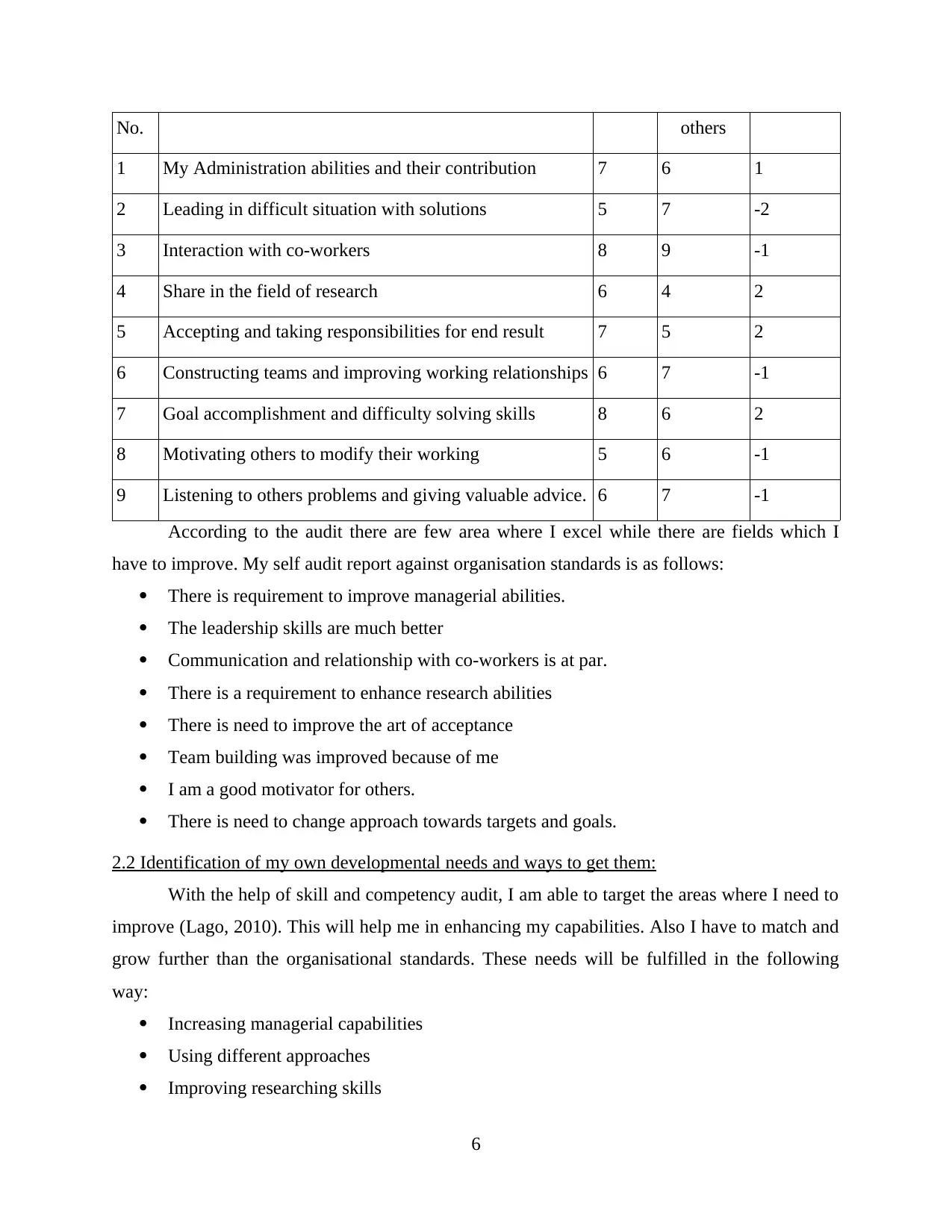
No. others
1 My Administration abilities and their contribution 7 6 1
2 Leading in difficult situation with solutions 5 7 -2
3 Interaction with co-workers 8 9 -1
4 Share in the field of research 6 4 2
5 Accepting and taking responsibilities for end result 7 5 2
6 Constructing teams and improving working relationships 6 7 -1
7 Goal accomplishment and difficulty solving skills 8 6 2
8 Motivating others to modify their working 5 6 -1
9 Listening to others problems and giving valuable advice. 6 7 -1
According to the audit there are few area where I excel while there are fields which I
have to improve. My self audit report against organisation standards is as follows:
There is requirement to improve managerial abilities.
The leadership skills are much better
Communication and relationship with co-workers is at par.
There is a requirement to enhance research abilities
There is need to improve the art of acceptance
Team building was improved because of me
I am a good motivator for others.
There is need to change approach towards targets and goals.
2.2 Identification of my own developmental needs and ways to get them:
With the help of skill and competency audit, I am able to target the areas where I need to
improve (Lago, 2010). This will help me in enhancing my capabilities. Also I have to match and
grow further than the organisational standards. These needs will be fulfilled in the following
way:
Increasing managerial capabilities
Using different approaches
Improving researching skills
6
1 My Administration abilities and their contribution 7 6 1
2 Leading in difficult situation with solutions 5 7 -2
3 Interaction with co-workers 8 9 -1
4 Share in the field of research 6 4 2
5 Accepting and taking responsibilities for end result 7 5 2
6 Constructing teams and improving working relationships 6 7 -1
7 Goal accomplishment and difficulty solving skills 8 6 2
8 Motivating others to modify their working 5 6 -1
9 Listening to others problems and giving valuable advice. 6 7 -1
According to the audit there are few area where I excel while there are fields which I
have to improve. My self audit report against organisation standards is as follows:
There is requirement to improve managerial abilities.
The leadership skills are much better
Communication and relationship with co-workers is at par.
There is a requirement to enhance research abilities
There is need to improve the art of acceptance
Team building was improved because of me
I am a good motivator for others.
There is need to change approach towards targets and goals.
2.2 Identification of my own developmental needs and ways to get them:
With the help of skill and competency audit, I am able to target the areas where I need to
improve (Lago, 2010). This will help me in enhancing my capabilities. Also I have to match and
grow further than the organisational standards. These needs will be fulfilled in the following
way:
Increasing managerial capabilities
Using different approaches
Improving researching skills
6
⊘ This is a preview!⊘
Do you want full access?
Subscribe today to unlock all pages.

Trusted by 1+ million students worldwide
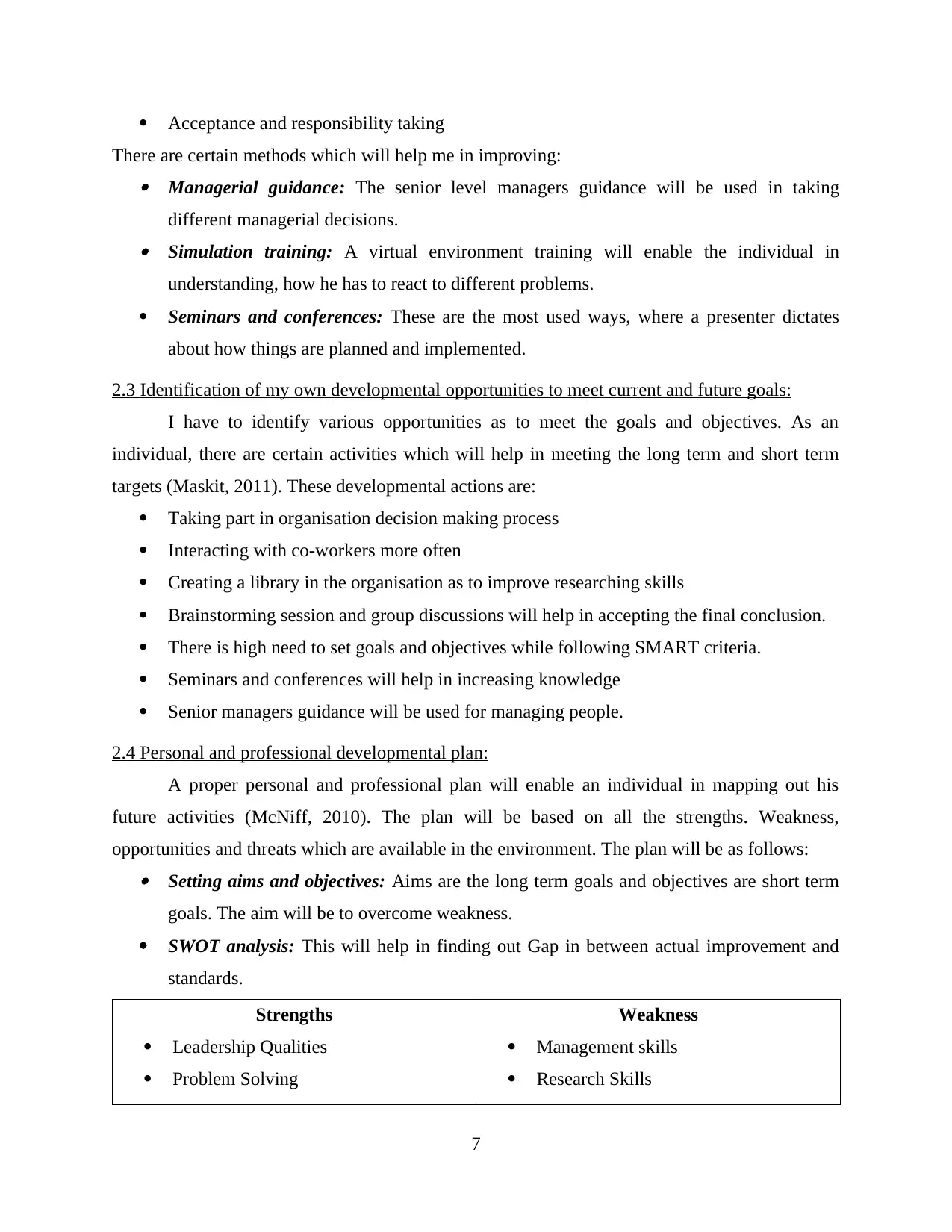
Acceptance and responsibility taking
There are certain methods which will help me in improving: Managerial guidance: The senior level managers guidance will be used in taking
different managerial decisions. Simulation training: A virtual environment training will enable the individual in
understanding, how he has to react to different problems.
Seminars and conferences: These are the most used ways, where a presenter dictates
about how things are planned and implemented.
2.3 Identification of my own developmental opportunities to meet current and future goals:
I have to identify various opportunities as to meet the goals and objectives. As an
individual, there are certain activities which will help in meeting the long term and short term
targets (Maskit, 2011). These developmental actions are:
Taking part in organisation decision making process
Interacting with co-workers more often
Creating a library in the organisation as to improve researching skills
Brainstorming session and group discussions will help in accepting the final conclusion.
There is high need to set goals and objectives while following SMART criteria.
Seminars and conferences will help in increasing knowledge
Senior managers guidance will be used for managing people.
2.4 Personal and professional developmental plan:
A proper personal and professional plan will enable an individual in mapping out his
future activities (McNiff, 2010). The plan will be based on all the strengths. Weakness,
opportunities and threats which are available in the environment. The plan will be as follows: Setting aims and objectives: Aims are the long term goals and objectives are short term
goals. The aim will be to overcome weakness.
SWOT analysis: This will help in finding out Gap in between actual improvement and
standards.
Strengths
Leadership Qualities
Problem Solving
Weakness
Management skills
Research Skills
7
There are certain methods which will help me in improving: Managerial guidance: The senior level managers guidance will be used in taking
different managerial decisions. Simulation training: A virtual environment training will enable the individual in
understanding, how he has to react to different problems.
Seminars and conferences: These are the most used ways, where a presenter dictates
about how things are planned and implemented.
2.3 Identification of my own developmental opportunities to meet current and future goals:
I have to identify various opportunities as to meet the goals and objectives. As an
individual, there are certain activities which will help in meeting the long term and short term
targets (Maskit, 2011). These developmental actions are:
Taking part in organisation decision making process
Interacting with co-workers more often
Creating a library in the organisation as to improve researching skills
Brainstorming session and group discussions will help in accepting the final conclusion.
There is high need to set goals and objectives while following SMART criteria.
Seminars and conferences will help in increasing knowledge
Senior managers guidance will be used for managing people.
2.4 Personal and professional developmental plan:
A proper personal and professional plan will enable an individual in mapping out his
future activities (McNiff, 2010). The plan will be based on all the strengths. Weakness,
opportunities and threats which are available in the environment. The plan will be as follows: Setting aims and objectives: Aims are the long term goals and objectives are short term
goals. The aim will be to overcome weakness.
SWOT analysis: This will help in finding out Gap in between actual improvement and
standards.
Strengths
Leadership Qualities
Problem Solving
Weakness
Management skills
Research Skills
7
Paraphrase This Document
Need a fresh take? Get an instant paraphrase of this document with our AI Paraphraser
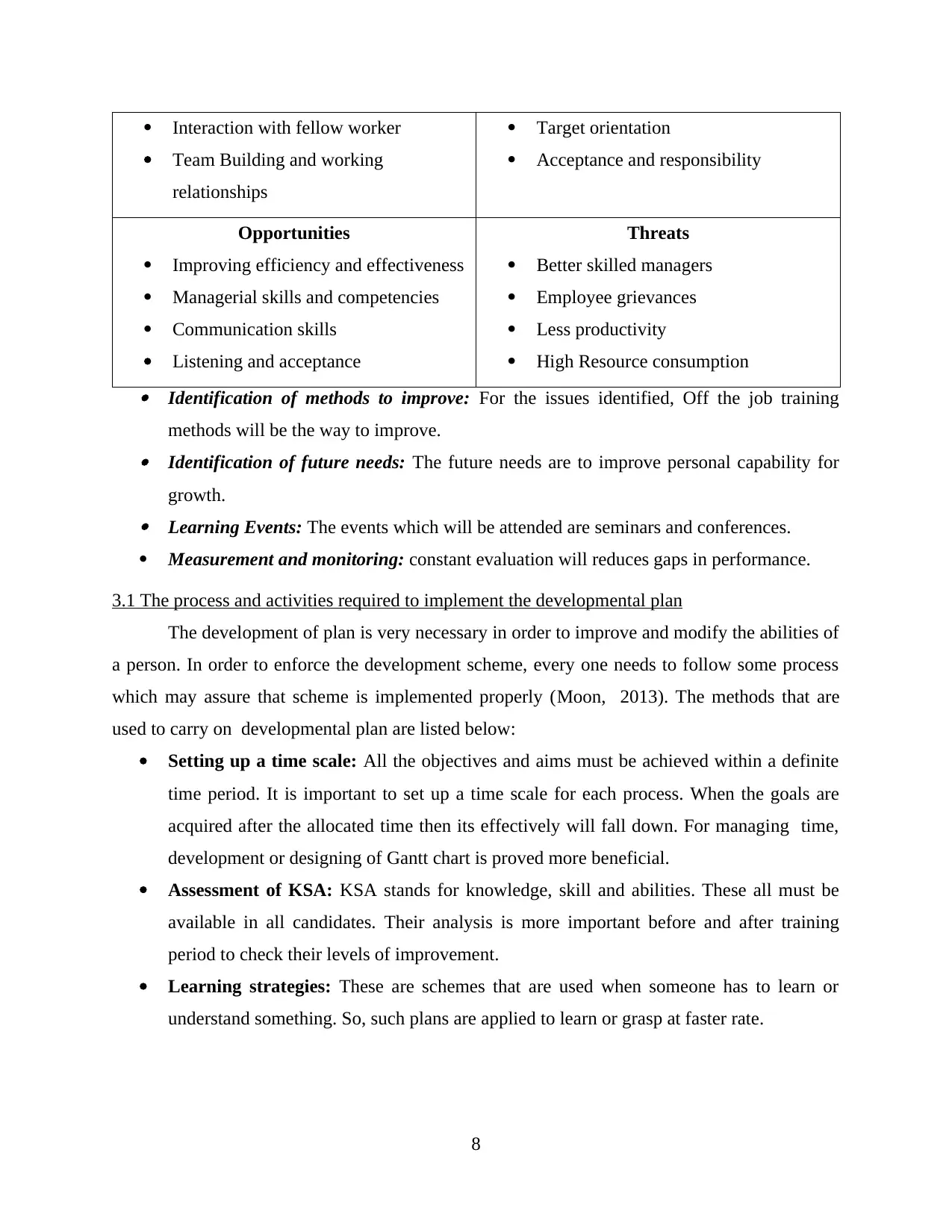
Interaction with fellow worker
Team Building and working
relationships
Target orientation
Acceptance and responsibility
Opportunities
Improving efficiency and effectiveness
Managerial skills and competencies
Communication skills
Listening and acceptance
Threats
Better skilled managers
Employee grievances
Less productivity
High Resource consumption Identification of methods to improve: For the issues identified, Off the job training
methods will be the way to improve. Identification of future needs: The future needs are to improve personal capability for
growth. Learning Events: The events which will be attended are seminars and conferences.
Measurement and monitoring: constant evaluation will reduces gaps in performance.
3.1 The process and activities required to implement the developmental plan
The development of plan is very necessary in order to improve and modify the abilities of
a person. In order to enforce the development scheme, every one needs to follow some process
which may assure that scheme is implemented properly (Moon, 2013). The methods that are
used to carry on developmental plan are listed below:
Setting up a time scale: All the objectives and aims must be achieved within a definite
time period. It is important to set up a time scale for each process. When the goals are
acquired after the allocated time then its effectively will fall down. For managing time,
development or designing of Gantt chart is proved more beneficial.
Assessment of KSA: KSA stands for knowledge, skill and abilities. These all must be
available in all candidates. Their analysis is more important before and after training
period to check their levels of improvement.
Learning strategies: These are schemes that are used when someone has to learn or
understand something. So, such plans are applied to learn or grasp at faster rate.
8
Team Building and working
relationships
Target orientation
Acceptance and responsibility
Opportunities
Improving efficiency and effectiveness
Managerial skills and competencies
Communication skills
Listening and acceptance
Threats
Better skilled managers
Employee grievances
Less productivity
High Resource consumption Identification of methods to improve: For the issues identified, Off the job training
methods will be the way to improve. Identification of future needs: The future needs are to improve personal capability for
growth. Learning Events: The events which will be attended are seminars and conferences.
Measurement and monitoring: constant evaluation will reduces gaps in performance.
3.1 The process and activities required to implement the developmental plan
The development of plan is very necessary in order to improve and modify the abilities of
a person. In order to enforce the development scheme, every one needs to follow some process
which may assure that scheme is implemented properly (Moon, 2013). The methods that are
used to carry on developmental plan are listed below:
Setting up a time scale: All the objectives and aims must be achieved within a definite
time period. It is important to set up a time scale for each process. When the goals are
acquired after the allocated time then its effectively will fall down. For managing time,
development or designing of Gantt chart is proved more beneficial.
Assessment of KSA: KSA stands for knowledge, skill and abilities. These all must be
available in all candidates. Their analysis is more important before and after training
period to check their levels of improvement.
Learning strategies: These are schemes that are used when someone has to learn or
understand something. So, such plans are applied to learn or grasp at faster rate.
8

Resources: There are different sources of learning such as books,
journals,internet,research materials, etc. Such resources can be used in training period as
per their need.
Evaluation and feedback resolution: The evaluation of all these training skills is
necessary in order to monitor gaps lying between current and required abilities. The
feedbacks are also resolved in order to provide proper satisfaction to individual.
3.2 Undertaking and documenting development activities as planned
There are following activities that are used to implement the development plan:
Training: Training must be provided in order to improve the managerial and logical
skills (Mwalongo, 2011). For this purpose, off the job training is applied or done. For
example, taking newcomers to attend seminars, separate or special programs, etc.
Learning strategies: The learning strategies are used so that improvement can be done
in real time learning.
Change management: This is necessary as to evaluate alteration that is done in attitude,
conceptualisation and capabilities of individual.
Monitoring and evaluation: In order to keep or notice improvement, monitoring and
evaluation is needed.
3.3 Evaluating own learning against the set objectives and standards
It is important to evaluate self learning skills after going through learning programmes in
order to understand their improvement. The better way to identify learning is evaluating
themselves in relation to set objectives and standards (Nicholls, 2014). By this way, I can
recognize the level of betterment. The below listed activities will aid higher posted members and
individual in re-evaluating the developmental plan:
Formal meet up preparation: This will assure that content and problems are ready to be
reflected among all members.
Utilisation of experience and knowledge: The experience holders and past knowledge
and experience will aids in measuring plans of development in order to remove the
loopholes that results in low improvement or betterment.
Anticipation and motivation: This is quite necessary as levels of motivation and
anticipation in each person will play a vital role in analysing plans as well as result. If
level of motivation is less or low then a new development plan is needed to made.
9
journals,internet,research materials, etc. Such resources can be used in training period as
per their need.
Evaluation and feedback resolution: The evaluation of all these training skills is
necessary in order to monitor gaps lying between current and required abilities. The
feedbacks are also resolved in order to provide proper satisfaction to individual.
3.2 Undertaking and documenting development activities as planned
There are following activities that are used to implement the development plan:
Training: Training must be provided in order to improve the managerial and logical
skills (Mwalongo, 2011). For this purpose, off the job training is applied or done. For
example, taking newcomers to attend seminars, separate or special programs, etc.
Learning strategies: The learning strategies are used so that improvement can be done
in real time learning.
Change management: This is necessary as to evaluate alteration that is done in attitude,
conceptualisation and capabilities of individual.
Monitoring and evaluation: In order to keep or notice improvement, monitoring and
evaluation is needed.
3.3 Evaluating own learning against the set objectives and standards
It is important to evaluate self learning skills after going through learning programmes in
order to understand their improvement. The better way to identify learning is evaluating
themselves in relation to set objectives and standards (Nicholls, 2014). By this way, I can
recognize the level of betterment. The below listed activities will aid higher posted members and
individual in re-evaluating the developmental plan:
Formal meet up preparation: This will assure that content and problems are ready to be
reflected among all members.
Utilisation of experience and knowledge: The experience holders and past knowledge
and experience will aids in measuring plans of development in order to remove the
loopholes that results in low improvement or betterment.
Anticipation and motivation: This is quite necessary as levels of motivation and
anticipation in each person will play a vital role in analysing plans as well as result. If
level of motivation is less or low then a new development plan is needed to made.
9
⊘ This is a preview!⊘
Do you want full access?
Subscribe today to unlock all pages.

Trusted by 1+ million students worldwide
1 out of 15
Related Documents
Your All-in-One AI-Powered Toolkit for Academic Success.
+13062052269
info@desklib.com
Available 24*7 on WhatsApp / Email
![[object Object]](/_next/static/media/star-bottom.7253800d.svg)
Unlock your academic potential
Copyright © 2020–2025 A2Z Services. All Rights Reserved. Developed and managed by ZUCOL.





